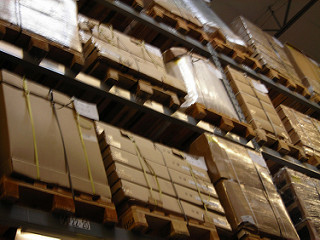If you’re part of the environmental discussion, then you’ve probably heard the term “big box store.” Most likely, you’ve heard that you should avoid big box stores because they’re bad for the environment (and also in some cases unfair to labor). It’s fine to use the term, and even to think in general that using a larger retailer isn’t as good as using a smaller, local retailer. However, it’s also important that when you use the term “big box retailer” you know why all of this is true. So what are big box retailers and why do many people suggest that you stay away from them? Let us explain!
Big Box Retailer or Store Defined
Big box stores were originally tagged “big box” because of the shape of the stores. Usually the layout resembles a large square or box when viewed from above. The defining characteristic of a big box store, however, is its large amount of floor space. Typically, for a store to truly be considered a big box store, it needs to take up more than 50,000 square feet of floor space. While big box stores are making their way into urban environments, because of the space requirements they are most often found in suburban and even rural environments. You’ll also hear big box stores called things like supercenters, superstores and megacenters. Those three names are the names that retailers give to the stores to sound more appealing than “big box store!”
There are usually two different kinds of big box stores. General merchandise big box stores like Target and Walmart carry a large variety of goods. There are also specialized types of big box stores that focus on a niche, such as Home Depot, Best Buy or Barnes and Noble.
The Early Days of Big Box: An Easy Benefit to Understand
When big box stores first started to pop up, people were excited to use them. The truth is that, at first, the ability of big box stores to leverage the huge volumes they were purchasing to create efficiency and reduce prices wasn’t necessarily a bad thing. However, like any process that celebrates massive consumption, big box stores didn’t take long to get out of control.
So Why Are Big Box Stores Bad for the Environment?
There are many complaints against big box stores that have nothing to do with the environment but are important issues. If you’re interested, there are plenty of articles online having to do with how big box stores harm workers’ rights, wages, and even human rights in the form of encouraging vendors and suppliers to use the cheapest form of labor for manufacturing in order to keep prices low. However, we’re not experts on social issues! What we *can* say is that there are extremely valid reasons why big box stores harm the environment.
All Suburban Sprawl is Bad for the Environment: While some big box stores are building an urban presence, the vast majority of them develop in suburban and rural areas because of the huge amounts of space needed to create “superstores.” Because of the size required, they typically (but, to be fair, not always) develop on what was once natural land, paving it over and creating huge infrastructures. At the end of the day, there’s almost always a development cost to be paid by the environment for the construction of a new big box store.
Low Eco-Consciousness in Manufacturing: Big box stores thrive because their prices are kept so low. To keep prices unreasonably low, it’s almost impossible to follow energy-friendly or eco-friendly practices. In fact, it’s no secret that the majority of merchandise made in big box stores is made in developing nations or nations with few environmental standards and that extreme pollution and greenhouse gas emissions are created in making the products.
Shopper Miles: Again, while this doesn’t apply to all big box stores, a huge number of them are created in suburban or rural environments where you need to drive to get your items. And often, it’s not an incredibly close drive. Since the model for big box stores is a large amount of space, many of them are farther away from populated areas than smaller retailers and stores would be.
Consumerist Encouragement: All stores by their very nature encourage consumerism because they want you to buy as much as possible! However, big box stores are more responsible for this than the average store. The business model of a big box store is that you will buy large volumes because the prices are lower, and most people do. By employing the method of encouraging quantity buying instead of quality buying, big box stores flood the world with more and more “stuff” that people most likely don’t need and that will later fill up landfills.
Low Quality = More Waste and More Consumption. At the end of the day, any time products are made with a low quality threshold in order to keep the price low, consumption and waste go up. It’s a pretty set formula, and big box companies are based on the low quality, low cost model.
If you’re interested in the lesser of the “evils,” Green America did a study of all of the big box stores and graded their environmental impact.
How do you feel about big box stores? Tell us about it on Facebook, Twitter, Pinterest or Instagram.
Photo: mirnanda via Flickr





